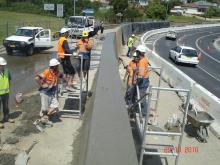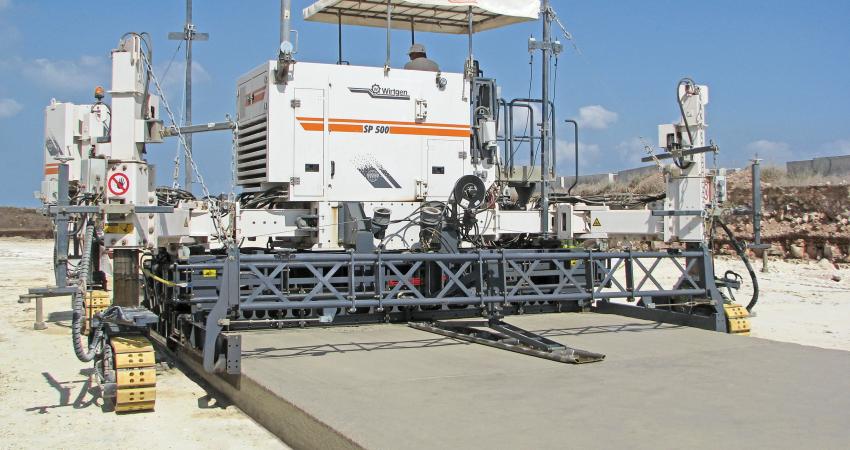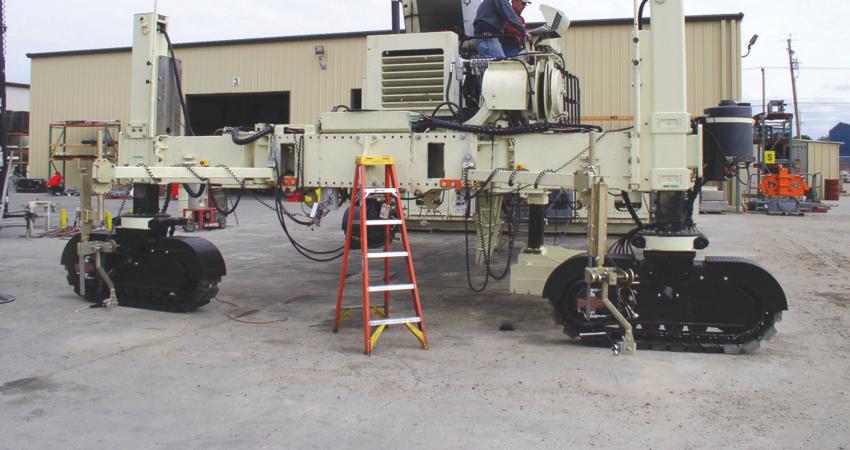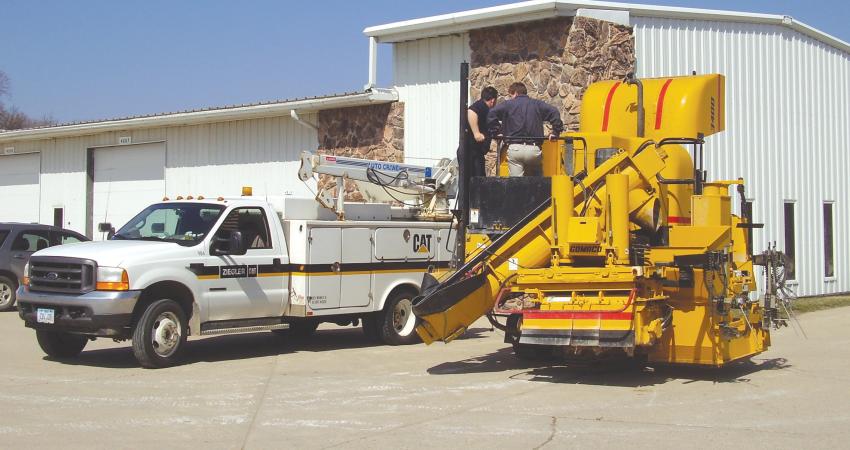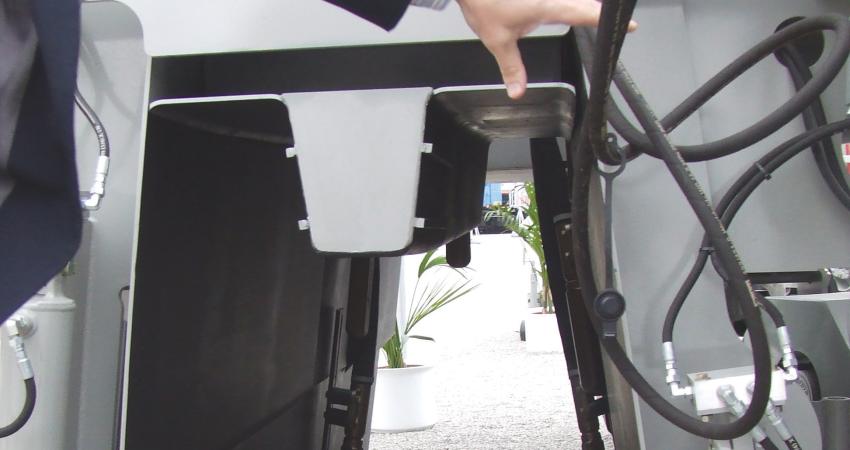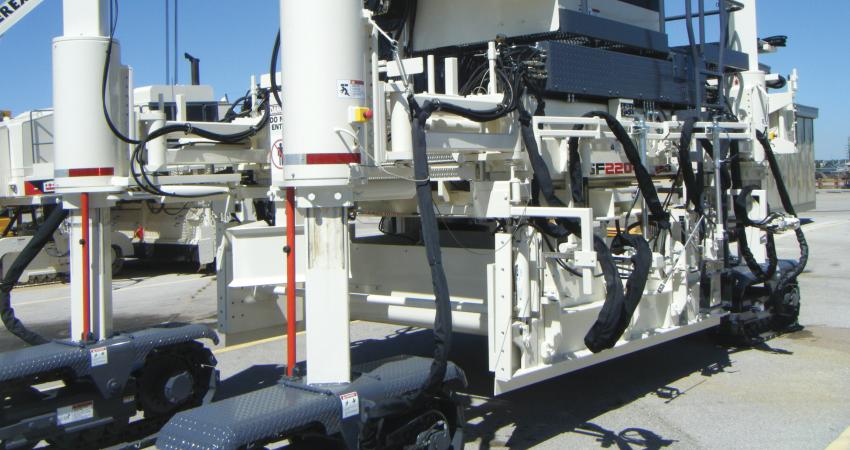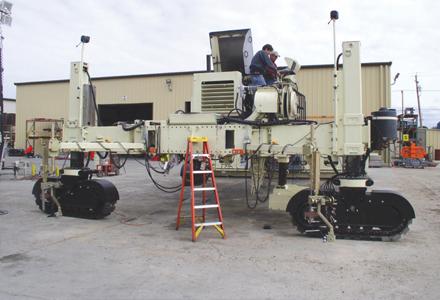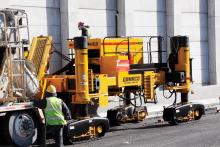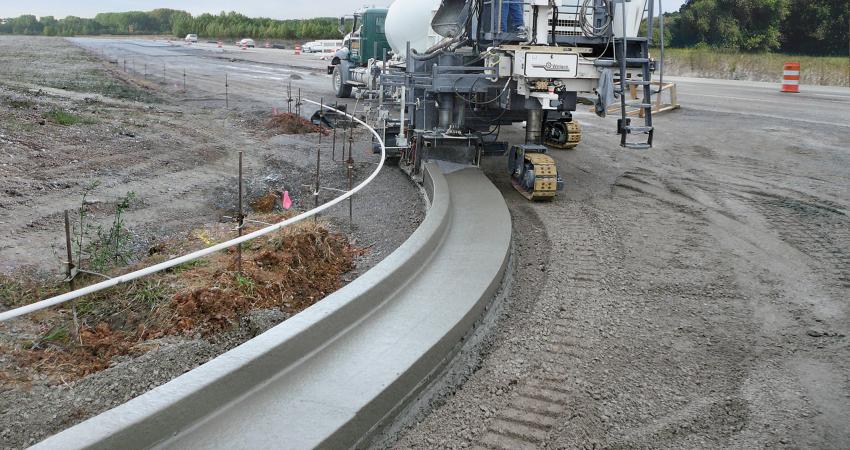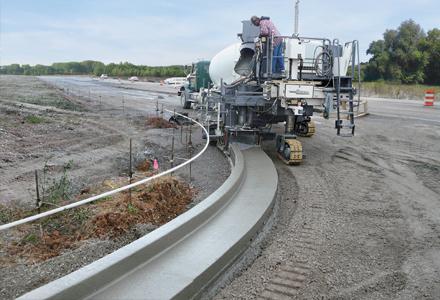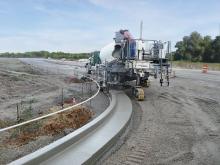Wirtgen is gearing up its operations in the concrete paving market - Mike Woof writes Concrete paving is a technology developed and pioneered in the US, so it is no surprise that US firms GOMACO, Guntert & Zimmerman, Power Curbers and Power Pavers, have had such a high profile in this market over the years. However one European firm, Wirtgen, is a serious competitor in the sector, the only non-US supplier to the market.
The control box can be easily lifted from a slot on one side of the machine to a similar slot on the other side if required to optimise visibility of the working area
Wirtgen is gearing up its operations in the concrete paving market - Mike Woof writes
Concrete paving is a technology developed and pioneered in the US, so it is no surprise that US firms218 GOMACO, 225 Guntert & Zimmerman, 307 Power Curbers and Power Pavers, have had such a high profile in this market over the years. However one European firm, 2395 Wirtgen, is a serious competitor in the sector, the only non-US supplier to the market.
Patrick Zanen is head of product management and sales for Wirtgen’s slipform paving division and says that the company has significantly upgraded its range in recent times, introducing a number of new models at the bauma exhibition in Munich last year. The two smallest models in the line-up are the SP15 and SP25, highly versatile machines that have been designed to carry out a wide range of tasks. Both models can be configured for either right or left pouring, by unbolting the mold. The control box can be quickly lifted up and moved over to the other side of the machine, allowing the operator a good field of view over the working area. The box can also be removed by the operator at the end of a shift if necessary, which boosts security as the machine cannot be used without this. Another key feature of the Wirtgen machines is that they can be configured with either hydraulic or electric vibration, allowing the customer to use existing molds if necessary.
Perhaps more than any other segment of the construction equipment business, the concrete paving sector sees more specialisation in terms of customer options on machines. Zanen said, “We have a standard machine range but I don’t know two that are the same.”
And to meet the needs of a UK customer, Wirtgen recently developed a highly modified version of the SP25. Zanen said, “We adapted an SP25 with a feeder underneath. It’s a custom-built machine but on a standard platform. The advantage is that he can drop the modification kit and use the machine as a conventional SP25 if he wants.” This machine will be reported on in greater detail in an upcoming issue of World Highways.
Manoeuvrability is as important as versatility for the SP15 and SP25, with these models offering tight turning circles for use in urban applications such as kerbing in parking lots. Control options are wide and Zanen said, “We can use a conventional stringline and steer both at the front and back.”
The electronics allow different machine control options to be used also and Zanen said, “If you have a 3D system you used to have to modify the sensitivity of the machine. Now we have a new interface and the standard function of the machine remains as it was and the 3D system does not go into the machine’s electronics.”
The smaller SP15 features two legs at the front and one at the back, which can be repositioned to the left or right, as required to suit the job (and the mold location on the frame). Meanwhile the larger SP25 is offered in both three and four track variants. The automatic engine controls will also increase or decrease rpm as required, such as if a trimmer is being used as this will increase the load on the machine.
The machines are specifially designed for European needs and Zanen said, “Our pavers are European made and we do have the CE mark.” He added that the machines have full vibration insulation for the operator platform, as well as comprehensive noise insulation around the engine to meet with the strict European requirements.
Given its European base, the company’s presence is understandably strong on the continent and Wirtgen now holds a dominant share of the French market for instance, with 78 units in the country. In Asia too Wirtgen has now developed its market share with 140 machines delivered. Wirtgen entered the US market with its concrete pavers only in the last few years and is developing a presence, although competition is particularly tough and the local manufacturers still hold strong market shares.
While Wirtgen competes hard against its rivals worldwide, Zanen said that there is one issue all the slipform paver manufacturers face and which he feels is holding back the wider use of concrete paving. “Worldwide the quality control has to be improved for concrete.”
Zanen said that dry mix designs offer considerable benefits, with less dehydration and less slump and a much lower risk of cracking than wet mix designs favoured in many areas. He added that dry mix designs also require less cement, reducing material costs. However he explained that dry mix designs do require the use of electric rather than hydraulic vibrators, which only newer generation machines may be able to use. Zanen also criticised poor preparation on many job sites, due to too many contracts being awarded on a lowest cost tender basis, resulting in a decrease in quality. Similarly, he added that training of paving crews can often be lacking and said, “The technology has many possibilities but the human factor needs to be improved.”
Concrete paving is a technology developed and pioneered in the US, so it is no surprise that US firms
Patrick Zanen is head of product management and sales for Wirtgen’s slipform paving division and says that the company has significantly upgraded its range in recent times, introducing a number of new models at the bauma exhibition in Munich last year. The two smallest models in the line-up are the SP15 and SP25, highly versatile machines that have been designed to carry out a wide range of tasks. Both models can be configured for either right or left pouring, by unbolting the mold. The control box can be quickly lifted up and moved over to the other side of the machine, allowing the operator a good field of view over the working area. The box can also be removed by the operator at the end of a shift if necessary, which boosts security as the machine cannot be used without this. Another key feature of the Wirtgen machines is that they can be configured with either hydraulic or electric vibration, allowing the customer to use existing molds if necessary.
Perhaps more than any other segment of the construction equipment business, the concrete paving sector sees more specialisation in terms of customer options on machines. Zanen said, “We have a standard machine range but I don’t know two that are the same.”
And to meet the needs of a UK customer, Wirtgen recently developed a highly modified version of the SP25. Zanen said, “We adapted an SP25 with a feeder underneath. It’s a custom-built machine but on a standard platform. The advantage is that he can drop the modification kit and use the machine as a conventional SP25 if he wants.” This machine will be reported on in greater detail in an upcoming issue of World Highways.
Manoeuvrability is as important as versatility for the SP15 and SP25, with these models offering tight turning circles for use in urban applications such as kerbing in parking lots. Control options are wide and Zanen said, “We can use a conventional stringline and steer both at the front and back.”
The electronics allow different machine control options to be used also and Zanen said, “If you have a 3D system you used to have to modify the sensitivity of the machine. Now we have a new interface and the standard function of the machine remains as it was and the 3D system does not go into the machine’s electronics.”
The smaller SP15 features two legs at the front and one at the back, which can be repositioned to the left or right, as required to suit the job (and the mold location on the frame). Meanwhile the larger SP25 is offered in both three and four track variants. The automatic engine controls will also increase or decrease rpm as required, such as if a trimmer is being used as this will increase the load on the machine.
The machines are specifially designed for European needs and Zanen said, “Our pavers are European made and we do have the CE mark.” He added that the machines have full vibration insulation for the operator platform, as well as comprehensive noise insulation around the engine to meet with the strict European requirements.
Given its European base, the company’s presence is understandably strong on the continent and Wirtgen now holds a dominant share of the French market for instance, with 78 units in the country. In Asia too Wirtgen has now developed its market share with 140 machines delivered. Wirtgen entered the US market with its concrete pavers only in the last few years and is developing a presence, although competition is particularly tough and the local manufacturers still hold strong market shares.
While Wirtgen competes hard against its rivals worldwide, Zanen said that there is one issue all the slipform paver manufacturers face and which he feels is holding back the wider use of concrete paving. “Worldwide the quality control has to be improved for concrete.”
Zanen said that dry mix designs offer considerable benefits, with less dehydration and less slump and a much lower risk of cracking than wet mix designs favoured in many areas. He added that dry mix designs also require less cement, reducing material costs. However he explained that dry mix designs do require the use of electric rather than hydraulic vibrators, which only newer generation machines may be able to use. Zanen also criticised poor preparation on many job sites, due to too many contracts being awarded on a lowest cost tender basis, resulting in a decrease in quality. Similarly, he added that training of paving crews can often be lacking and said, “The technology has many possibilities but the human factor needs to be improved.”

